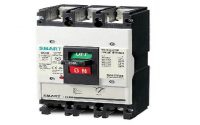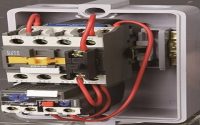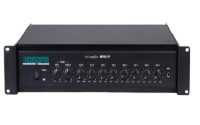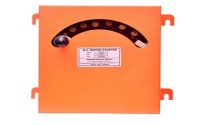What is a Pulse Transformer : Working & Its Applications
A pulse transformer is one of the most widely utilized custom transformers in different industries. Generally, vacuum devices mainly work in high power pulse voltage which is generated by high power-based pulse transformers. These transformers have a compact structure & outstanding repetitiveness. In most of the applications, it is expected of wide pulse width, short rise time & transferring of huge energy efficiency.
These transformers are mainly designed to hold high loads for distributing power. These are capable of transmitting huge power as compared to a normal transmitter with similar size & it can work on high frequencies. There are many reasons why in different industrial areas, these transformers are mostly considered. This article discusses an overview of a pulse transformer and its working.
What is a Pulse Transformer?
A pulse transformer is one kind of transformer that is designed & optimized for voltage pulse transmission in between its two windings as well as to the connected load. These types of transformers are used for the transmission of signals in control circuits with less power & the essential components within high-power SMPS. The Pulse transformer diagram is shown below.
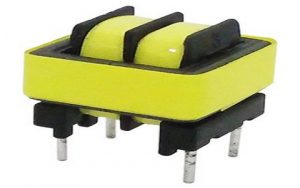
These transformers handle currents & voltages in the pulse form so mostly utilized like Isolating Transformers within power electronic circuits to separate source & load. This kind of transformer is used in radar, TV, digital computers, and many more. The main functions of pulse transformer are;
- The voltage pulse amplitude can be changed
- The pulse polarity can be changed
- Pulse amplifier’s different stages can be coupled
- Used like an Isolation Transformer
Pulse Transformer Design
The design of a pulse transformer mainly depends on different parameters like inductance, power rating, impedance, low to high voltage level, size, operating frequency, frequency response, winding capacitance, packaging, etc.
Transformer designers try to reduce parasitic elements like capacitance of winding, leakage inductance through configurations of winding which optimizes the coupling among the transformer windings. This transformer can be designed in different types sizes & shapes through manufacturers like Butler Winding by including different standard type structures.
The size of pulse transformers is small & includes fairly fewer turns. Thus the windings leakage inductance is least & the interwinding capacitance of these transformers has less
The magnetizing inductance of the pulse transformer is high because the cores are designed with ferrites otherwise wound strips of alloys with high permeability. These types of transformers include insulation with high voltage in between two windings & toward the ground. Usually, these transformers handle the pulse signal otherwise train the pulse.
The impulse transformers’ performance is mainly specified through its effect on the outline of the pulse input voltage or current. Small pulse transformers are mainly used in pulse generators, computers, etc. Large pulse transformers are mainly used in radar systems to deliver 50 to100 MW of power at 200 to 300 kV in a few microseconds.
Types of Pulse Transformer
Pulse transformers are classified into two types like power pulse transformers & signal pulse transformers. Power pulse transformers are used to change the power-level voltages from one range to another. These types of transformers are available in either 1-phase or 3-phase primary designs or changes based on the connected winding.
Signal transformers use electromagnetic induction for transmitting data from one type of circuit to another circuit. So these are used most frequently to enhance or reduce the voltage from one face of a power transformer to another face. By using these transformers, the number of windings turns ratio will decide the voltage change.
Construction/Working
The pulse transformer’s main function is to produce a signal for a semiconductor device as well as to give electrical isolation. A toroidal-shaped pulse transformer is shown below which includes two windings like primary & secondary. The pulse transformer construction is shown below.
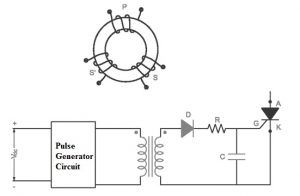
- Every winding includes equivalent turns so any winding can work like primary otherwise secondary winding.
- The signal given to silicon-controlled rectifier can be given through the ratio of 1:1 otherwise 1:1:1 of the transformer.
- The continuous signal to the SCR can be provided by the 3-winding based transformer.
- The gate signal of the firing circuit through the pulse transformer can be given in the second diagram.
- The series resistor function is to restrict the rectifier’s holding current.
- Here, the diode ‘D’ is used to avoid reversing gate current and 1:1:1 pulse transformer can be used for generating pulse continuously to SCR.
- The 3-winding pulse transformer is shown above. The designing of this transformer can be done with high efficiency. The primary winding’s inductance must be high to decrease the magnetizing current. The direct current supplied throughout the primary winding in the transformer can prevent the saturation of the core.
- The winding of the transformer can be protected through the insulation in between the two windings. So, tight coupling must be necessary between two windings. The stray signal gives lane throughout inter-stage capacitance on a high frequency.
- There is a frequency effect on the output signal. The output signals shape & frequency and input signal are the same for high signal frequency. So, the output is directly proportional to the incorporation of input on low signal frequency.
Specifications
The specifications of the pulse transformer mainly include different parameters which are associated with o/p response. These parameters will define the permissible pulse distortion limits.
Pulse Amplitude
Pulse amplitude is the highest peak value of the signal apart from the useless spikes.
Rise Time (Tr)
Rise time is the time received by the output signal to enhance from 10% to 90% of peak pulse amplitude in the primary attempt. In some cases, it may be described as the time received by the output signal response to increasing from zero to pulse amplitude for the initial time.
Over Shoot
The output signal which exceeds the peak amplitude is known as overshoot.
Pulse Width
The interval of time in between the first & last instants where the instantaneous amplitude attains 50% of the peak amplitude is known as pulse width or pulse duration
Droop
Droop is the pulse amplitude displacement throughout its level response and it is also called tilt.
Fall time (Tf)
Fall time can be defined as the time taken through the output signal to reduce the peak amplitude from 90% to 10% throughout the response of the trailing edge. It is also known as decay time.
Backswing
The part of the trailing edge which expands under the level of zero amplitude is known as the backswing.
Pulse Transformer Uses/ Applications
The applications of pulse transformers include the following.
- Pulse Generating Circuits
- Analog Switching Applications
- SCR
- Power Electronics
- Data Handling Circuits
- Radar
- Switching Transistors
- Communication
- Microwave Tube Circuits
- Control Circuit for Firing Control
- Cathode Ray Tube (CRO) Circuits
- Radar Systems
- Digital Electronics
- The transmission line pulse transformer is mainly used in the applications of quick transmission of pulse signal & also in digital signal transmission.
Advantages & Disadvantages
The advantages of pulse transformer include the following.
- Small in Size
- High Isolation Voltage
- Inexpensive
- Exterior Power Supply is not Required
- It Operates at High Frequency.
- It is Capable For Transmitting High Energy
- Includes More Windings
- Avoids Stray Currents
- It Gives Insulation & Control
The disadvantages of pulse transformer include the following.
- At low frequency, both the output waveforms are different from each other
- The DC supplies throughout primary winding to decrease the saturation of the core.
- This Kind of Transformer Saturates at Fewer Frequencies. Thus it can be utilized for only maximum frequencies only.
- The Signal is Unclear Because of The Magnetic Coupling
Thus, this is all about an overview of the pulse transformer and its working. This transformer is mainly optimized to transmit electrical pulse or voltage or current pulse. This transformer couples the signal from primary to secondary winding to protect the outline. So the performance of the pulse transformer can be reviewed by measuring the transformer’s effect on the outline of the exterior signal. So its performance factor mainly depends on the outline of the output signal. Here is a question for you, what are the pulse transformer operating principles?

